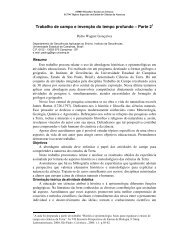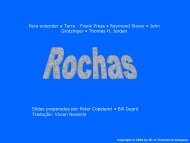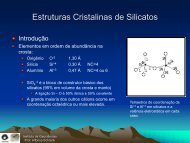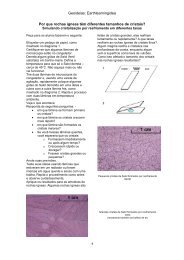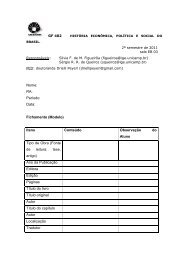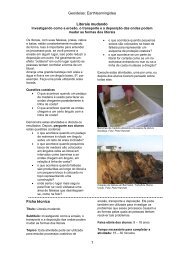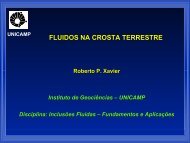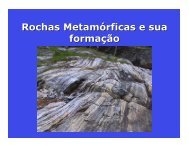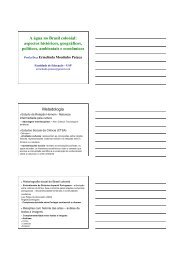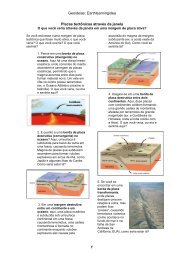Q-Mode and R-Mode Factor Analysis in Quantitative Studies of ...
Q-Mode and R-Mode Factor Analysis in Quantitative Studies of ...
Q-Mode and R-Mode Factor Analysis in Quantitative Studies of ...
You also want an ePaper? Increase the reach of your titles
YUMPU automatically turns print PDFs into web optimized ePapers that Google loves.
TERRÆ 7(1-2):41-49, 2010Hirama, M. V., Toledo, F. A. de L., Junior, E. C., Costa, K. B., Quadros, J. P. dedepths dur<strong>in</strong>g their reproduction period <strong>in</strong> w<strong>in</strong>ter,when the vertical density gradient is reduced. G.ruber (p<strong>in</strong>k) <strong>and</strong> G. <strong>in</strong>flata were also associated t<strong>of</strong>actor 3 to stratified waters (Hilbrecht, op.cit.). Asa consequence <strong>of</strong> G. truncatul<strong>in</strong>oides <strong>and</strong> G. <strong>in</strong>flatatolerance to little variation <strong>in</strong> sal<strong>in</strong>ity, factor 3 canbe related to sal<strong>in</strong>ity as well. Both forms <strong>of</strong> Globiger<strong>in</strong>oidessacculifer, which have a preference for themixed layer (Fairbanks et al. 1982; Ravelo et al.,1990; Andreasen e Ravelo, 1997), were the greatestcontribution to factor 5. Thus it was <strong>in</strong>terpreted asmixed layer factor. F<strong>in</strong>ally, factor 9 was regarded astemperature <strong>in</strong>fluenced because <strong>of</strong> warm speciesG. menardii tumida <strong>and</strong> G. menardii flexuosa relationship(Hemleben et al., 1989). When taken factorscores <strong>in</strong>to account along with biostratigraphiczones Y <strong>and</strong> Z <strong>and</strong> oxygen isotopic data (Figure 8)thermocl<strong>in</strong>e (factor 1) seems to go along with theoxygen trend. Thermocl<strong>in</strong>e factor behaviour followedthe temperate water conditions (factor 2)<strong>in</strong> the course <strong>of</strong> biozone Y. The factor <strong>in</strong>terpretedas stratification or sal<strong>in</strong>ity variation (factor 3) presentedan opposite tendency to factor 4 (l<strong>in</strong>ked toGlobiger<strong>in</strong>ella digitata <strong>and</strong> Hastiger<strong>in</strong>a digitata). Frombase-core to about 20,000 years ago (biozone Y)mixed layer control (factor 5) seems to mirror factor6 (Turborotalia qu<strong>in</strong>queloba <strong>and</strong> Globoturborotalitatenella), from then on, the two curves appearedco<strong>in</strong>cident. There were not comparative patternsobserved among the other factors.Figure 7 – SAN-76 Q-mode factor 1 <strong>and</strong> 2 histograms<strong>in</strong>dicat<strong>in</strong>g factor scores <strong>of</strong> the taxa analysed5. Conclusionthe application <strong>of</strong> Q- <strong>and</strong> R-mode factor analysisto micr<strong>of</strong>ossil compositional data sets was usefulto reconstruct the most prom<strong>in</strong>ent environmentalparameters <strong>in</strong>herent to planktonic foram<strong>in</strong>ifera orcalcareous nann<strong>of</strong>ossils fluctuations <strong>in</strong> the past.Greater correlation coefficients (0.9 to average)confers more reliability to the Q-mode techniquecompared to the R-mode for which only a third <strong>of</strong>the correlation coefficients were higher than 0.3.Additionally, the amount <strong>of</strong> R-mode statisticallysignificant factors was larger. This is consistentwith natural conditions where several parametersact simultaneously <strong>in</strong> a given community. However,<strong>in</strong>terpretations <strong>of</strong> these factors could be ahard task s<strong>in</strong>ce factors correlate to species whoseecological preferences are unclear or unknown. Areduced amount <strong>of</strong> reta<strong>in</strong>ed factors <strong>of</strong> Q-modeshow a relationship with the most abundant species,yield<strong>in</strong>g easier <strong>in</strong>terpretation parameters.Compar<strong>in</strong>g the application <strong>of</strong> both techniqueson calcareous nann<strong>of</strong>ossils <strong>and</strong> planktonicforam<strong>in</strong>ifera it was possible to recognize some similaritiesamong factors. The significance <strong>of</strong> PC-01factor 1 <strong>and</strong> SAN-76 factor 2 Q-mode results areanalogous <strong>and</strong> related to the same time <strong>in</strong>terval:glacial period <strong>in</strong>fluenced by surface water productivity.Along these l<strong>in</strong>es PC-01 factor 2 (nutricl<strong>in</strong>e/thermocl<strong>in</strong>e) <strong>and</strong> SAN-76 factor 1 (mixed layer)<strong>in</strong>dicates the control <strong>of</strong> water stratification dur<strong>in</strong>gthe <strong>in</strong>terglacial.Temperature-related R-mode factors (PC-01factor 1; SAN-76 factor 2 <strong>and</strong> 9) attend to the samebiota response although any temporal connectioncould be found. In this way PC-01 factor 2 <strong>and</strong>SAN-76 factor 1 <strong>and</strong> 5 l<strong>in</strong>ked to water stratification.These factors showed oscillat<strong>in</strong>g curves throughoutthe cores, but could be associated to majorrelevance <strong>in</strong> biozone Y. F<strong>in</strong>ally PC-01 factor 4 <strong>and</strong>SAN-76 factor 3 should be considered <strong>in</strong>dicat<strong>in</strong>gequivalent conditions s<strong>in</strong>ce they dwell on productivity<strong>in</strong>ductions (lower vertical gradient) or sal<strong>in</strong>ityissues for both groups <strong>of</strong> organisms.The lack <strong>of</strong> correspondence between Q-modereta<strong>in</strong>ed factor <strong>and</strong> those from R-mode approach47a5_t7.<strong>in</strong>dd 47 27/01/2011 11:28:06



